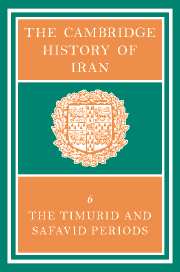Book contents
- Frontmatter
- 1 THE JALAYIRIDS, MUZAFFARIDS AND SARBADĀRS
- 2 TĪMŪR IN IRAN
- 3 THE SUCCESSORS OF TĪMŪR
- 4 THE TÜRKMEN DYNASTIES
- 5 THE SAFAVID PERIOD
- 6 THE SAFAVID ADMINISTRATIVE SYSTEM
- 7 EUROPEAN CONTACTS WITH PERSIA, 1350–1736
- 8 TRADE FROM THE MID-14TH CENTURY TO THE END OF THE SAFAVID PERIOD
- 9 SOCIAL AND INTERNAL ECONOMIC AFFAIRS
- 10 THE EXACT SCIENCES IN TIMURID IRAN
- 11 PERSIAN SCIENCE IN SAFAVID TIMES
- 12 RELIGION IN THE TIMURID AND SAFAVID PERIODS
- 13 SPIRITUAL MOVEMENTS, PHILOSOPHY AND THEOLOGY IN THE SAFAVID PERIOD
- 14 CARPETS AND TEXTILES
- 15 (a) TIMURID ARCHITECTURE
- (b) SAFAVID ARCHITECTURE
- 16 (a) THE PICTORIAL ARTS IN THE TIMURID PERIOD
- (b) THE ARTS IN THE SAFAVID PERIOD
- 17 (a) PERSIAN LITERATURE IN THE TIMURID AND TÜRKMEN PERIODS (782–907/1380–1501)
- (b) HĀFIZ AND HIS CONTEMPORARIES
- (c) PERSIAN LITERATURE IN THE SAFAVID PERIOD
- 18 PERSIAN POETRY IN THE TIMURID AND SAFAVID PERIODS
- Bibliographies
- Plate section
- Plate section
- Plate section
- Maps
- References
13 - SPIRITUAL MOVEMENTS, PHILOSOPHY AND THEOLOGY IN THE SAFAVID PERIOD
Published online by Cambridge University Press: 28 March 2008
- Frontmatter
- 1 THE JALAYIRIDS, MUZAFFARIDS AND SARBADĀRS
- 2 TĪMŪR IN IRAN
- 3 THE SUCCESSORS OF TĪMŪR
- 4 THE TÜRKMEN DYNASTIES
- 5 THE SAFAVID PERIOD
- 6 THE SAFAVID ADMINISTRATIVE SYSTEM
- 7 EUROPEAN CONTACTS WITH PERSIA, 1350–1736
- 8 TRADE FROM THE MID-14TH CENTURY TO THE END OF THE SAFAVID PERIOD
- 9 SOCIAL AND INTERNAL ECONOMIC AFFAIRS
- 10 THE EXACT SCIENCES IN TIMURID IRAN
- 11 PERSIAN SCIENCE IN SAFAVID TIMES
- 12 RELIGION IN THE TIMURID AND SAFAVID PERIODS
- 13 SPIRITUAL MOVEMENTS, PHILOSOPHY AND THEOLOGY IN THE SAFAVID PERIOD
- 14 CARPETS AND TEXTILES
- 15 (a) TIMURID ARCHITECTURE
- (b) SAFAVID ARCHITECTURE
- 16 (a) THE PICTORIAL ARTS IN THE TIMURID PERIOD
- (b) THE ARTS IN THE SAFAVID PERIOD
- 17 (a) PERSIAN LITERATURE IN THE TIMURID AND TÜRKMEN PERIODS (782–907/1380–1501)
- (b) HĀFIZ AND HIS CONTEMPORARIES
- (c) PERSIAN LITERATURE IN THE SAFAVID PERIOD
- 18 PERSIAN POETRY IN THE TIMURID AND SAFAVID PERIODS
- Bibliographies
- Plate section
- Plate section
- Plate section
- Maps
- References
Summary
THE BACKGROUND
The Safavid period is one of the outstanding epochs in the intellectual and spiritual history of Islamic Iran, although its artistic and political life is much better known to the outside world than what it created in the domains of sufism, philosophy and theology. Particularly in Hikmat – that combination of philosophy and gnosis which should be translated as theosophy rather than philosophy as currently understood in the Occident – the Safavid period is the apogee of a long development which reaches back to the 6th/12th century and the introduction of new intellectual perspectives into Islamic civilisation by Suhravardī and Ibn 'Arabī. Likewise, in sufism and the religious sciences the sudden flowering of activity in the 10th/16th century is based on the important but little studied transformation that was taking place in Persia since the Mongol invasion.
Persia did not become Shī'ī through a sudden process. Ever since the 7th/13th century Shi'ism was spreading in Persia through certain of the sūfī orders which were outwardly Sunnī – that is, in their madhhab they followed one of the Sunnī schools, usually the Shāfi'ī. But they were particularly devoted to 'Alī and some even accepted wilāya (or valāyat, in its Persian pronunciation), that is, the power of spiritual direction and initiation which Shī'īs believe was bestowed upon 'Alī by the Prophet of Islam. It was particularly this belief that made the transformation of Persia from a predominantly Sunnī land to a Shī'ī one possible. The Shī'īs consider Safī al-Dīn Ardabīlī, the founder of the Safavid order, as a Shī'ī, whereas the research of modern historians has revealed him to be a Sunnī.
- Type
- Chapter
- Information
- The Cambridge History of Iran , pp. 656 - 697Publisher: Cambridge University PressPrint publication year: 1986
References
- 5
- Cited by

